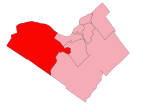CFS Carp Dunrobin Detachment
1962 establishments in Ontario1994 disestablishments in OntarioCanadian Forces bases in OntarioCanadian military stubsMilitary radio systems
The Dunrobin Detachment was a military-operated radio communications receiver station linked by land line to CFS Carp located on the corner of Dunrobin Road and Vance's Side Road NW of Dunrobin, Ontario. A second antenna receiver site was located further West near Almonte, Ontario; the Almonte Detachment. The detachment was unmanned and the location primarily used as a remote antenna farm. After the end of the Cold War, CFS Carp was decommissioned and the antenna site was no longer needed.
Excerpt from the Wikipedia article CFS Carp Dunrobin Detachment (License: CC BY-SA 3.0, Authors).CFS Carp Dunrobin Detachment
Vances Side Road, Ottawa
Geographical coordinates (GPS) Address Nearby Places Show on map
Geographical coordinates (GPS)
| Latitude | Longitude |
|---|---|
| N 45.448407 ° | E -76.047474 ° |
Address
Vances Side Road
K0A 1T0 Ottawa (West Carleton-March)
Ontario, Canada
Open on Google Maps




